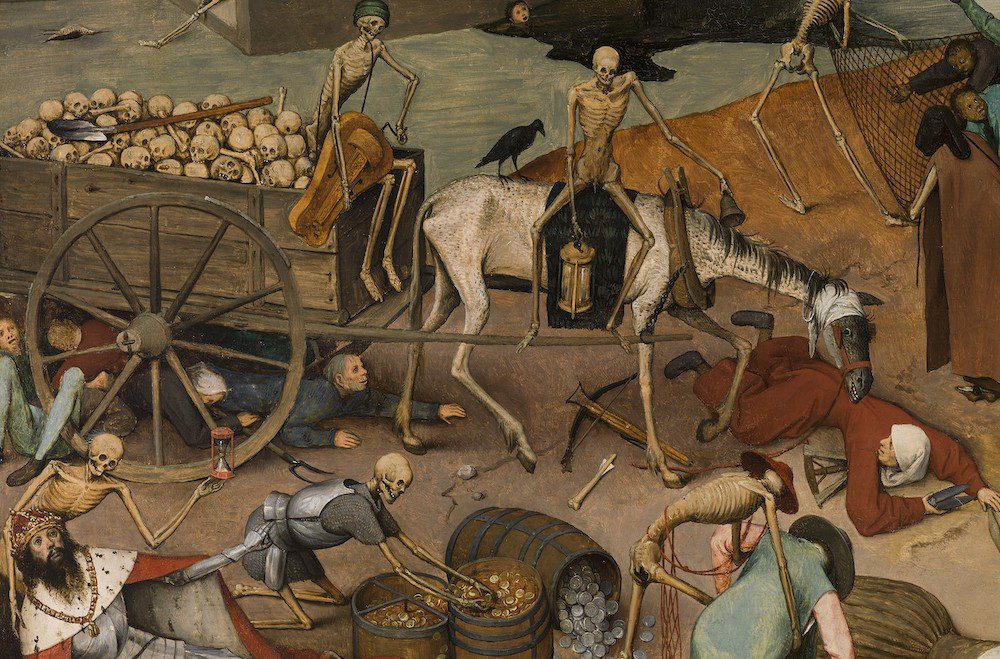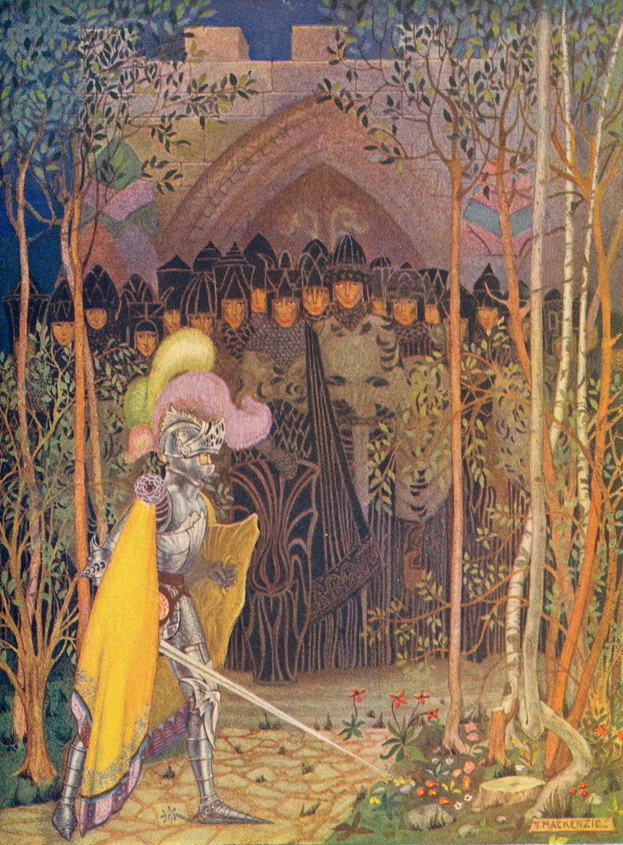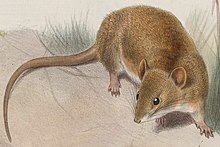A Food Chain of Corpses
The Waste Land deals with numerous motifs all at once. From the cyclical routine of nature and the Great War’s effects on humanity to another significant conflict – the battle of the sexes, these matters seem disconnected at first glance. However, with further investigation and references to the sources that influenced Eliot’s writing, these themes are in fact connected through the subjects of this page – corpses and bones.
Eliot references Baudelaire’s “The Martyred Woman” towards the outset of II. A Game of Chess. Particularly through creating an ambience in this section of TWL similar to that of Baudelaire’s poem, one is prompted to analyze the beautified death scene where “A headless cadaver”, who is the eponymous martyred woman, lays (Baudelaire). The fact that this female corpse is “headless” alludes to the lost of the most identifiable aspect of any human, the face, proceeding the exploitation of her body for men’s sexual desires; her identity is not spared even after her life has already ended, proving the significant stripping of humanity of indecent sex. Baudelaire continues,
“Had her exasperated soul / And her senses gnawed by ennui / Thrown open their gates to the thirsty pack / Of lost and wandering desires?… Did he use your inert, complacent flesh to fill /The immensity of his lust?” (Baudelaire).
Incorporating the action “gnawed by” alludes to the female corpse being a mere feed for “the thirsty pack”. The corpse’s “inert, complacent flesh” merely exists as a prey to quench such predating men’s sexual thirst. With corporeal flesh comes bones, and bones first appear in TWL when Eliot writes, “I think we are in rats’ alley / Where the dead men lost their bones” (115-116). This scene occurs only numerous lines after the reference to “The Martyred Woman”, deeming the transition from a female corpse to “dead men” significant. Here, as opposed to Baudelaire’s woman who lost her flesh to figuratively feed men, “dead men lost their bones” to a currently unknown source. The essence of losing bones hints at such men’s loss of a stable structure. Evidently, when men are guided only by lust, their upstanding propriety dies, resulting in the metaphorical death of masculine morality, deeming them “dead men”.
Yet, of course, corpses exist beyond this battle of the sexes; a larger phenomenon gives rise for greater casualties and death – WWI. Whitman’s depictions of “battle-corpses, myriads of them, / And the white skeletons of young men” further convey men’s subjectivity to battle casualties, as they were the prominent gender who engaged in this war (Whitman 6). Their “white skeletons” exposed on the battlefield similarly depict the scene where “dead men lost their bones”, painting the Great War as a more powerful source of predator than men are to women. However, even war isn’t the most powerful of them all; the inevitable nature of death. Female corpses that are supposedly prominent with “beauty” are merely “formless, shapeless, and without glory,” as Pepler put it, when “laid in the graves” (The Burial of the Dead 14). He also notes that “man is but naked bones, corruption, and food for worms”; their corpses, stripped of uprightness and corrupted with lust, merely act as prey to the most trivial animals after death, which contributes to the cycle of nature through a food chain sequence (The Burial of the Dead 20).

Dwight Longenecker, T.S. Eliot’s Waste Land, Reconsidered in the Pandemic (2020)
The Bones of Ezekiel
“And He said unto me, ‘Son of man, can these bones live?’ And I answered, ‘O Lord GOD, Thou knowest.'” (Ezekiel 37:3)
Of the many Biblical references in The Waste Land none contribute quite as much to the structure and symbolism of the poem as the Book of Ezekiel, which is first introduced in line twenty and makes numerous reappearances throughout the poem. One of the most notable sections of Ezekiel, the Valley of Dry Bones, is a prophecy that God reveals to Ezekiel of how he will redeem the Israelites, raising the dead. The chapter opens, “the hand of the LORD… set me down in the midst of the valley which was full of bones… and there were very many in the open valley; and, lo, they were very dry” (Ezekiel 37:1-2).

The Vision of the Valley of the Dry Bones by Gustave Doré
Of the numerous times bones and corpses appear in the appear in The Waste Land, only once are they ‘dry:’
“Over the tumbled graves, about the chapel
There is the empty chapel, only the wind’s home
It has no windows, and the door swings,
Dry bones can harm no one.” (388-391)
Bones here become the seeds of the prophecy, but, when God raises them into an army of the dead, in Ezekiel, “So I prophesied as He commanded me, and the breath came into them, and they lived, and they stood up upon their feet, an exceeding great army” (Ezekiel 37:10). Here, in The Waste Land, the “dry bones,” the dead of the House of Israel [Israelites], “can harm no one” (Eliot 391). The theme of prophecy is not new to The Waste Land, but the connection to bones appears only here, suggesting something unique about how the Biblical vision lines up with the previous examples (Huxley, Petronius, etc.).
The “empty chapel” in this stanza is the Chapel Perilous of Arthurian legend, where the hero must enter and defeat the cursed and murderous spirit within (Weston 1-3). The connection here is not directly with Ezekiel, but with bones themselves. The story of this chapel is that every day a knight, thinking they are virtuous and strong enough, will enter, and be slain by the “Black Hand” (Weston 2). This, in effect, is an army similar to that of the reanimated dead that Ezekiel sees, slain by their own ‘sins’ and awaiting deliverance (from Gawain). The ‘dryness’ here is more than just a reference to Ezekiel, but an actual trait, the languishing in sin and idolatry that God instructed Ezekiel to deliver the Israelites from. This is clarified in a line from Ezekiel itself, as the reanimated corpses speak, “Our bones are dried, and our hope is lost: We are cut off for our parts” (Ezekiel 37:11). Here the status of ‘dried’ is directly connected with the conditions/actions of the bones; this must also be applied to The Waste Land.

“The Chapel Perilous” by Thomas Mackenzie
The ‘harmlessness’ of these ‘dry bones’ is less easy to interpret. Much more explicit than the commentary and satire of prophets from Madame Sosostris and Sybil (in the foreword), this passage directly contradicts the Ezekiel vision of redemption and resurrection. By associating with the Chapel Perilous, which is cited as containing the bones of all who fell to it in its mausoleum in From Ritual to Romance, the nature of this is made clear. Bones are the enduring legacy of the people they belonged to, and their attributes are somewhat permanent—only an act of God can raise the ‘dry,’ idolatrous bones of the House of Israel. Only with the presence of an Ezekiel/Gawain-type character—the pure prophet/quester—can these bones even be raised, and, as “only the wind’s home,” there is no one left to fulfill the prophecy and redeem the bones, which here make up not the House of Israel, but the ‘House of Britain.’ To Eliot, bones serve much of the same purpose, a reminder of the shortcomings he sees in modern British life, the ‘dry bones’ of the Chapel Perilous exhumed in the City of London.

Daniele Castellano, T.S. Eliot Saw All This Coming (2022)
Implicit Bones
In “The Fire Sermon,” an arbitrary corpse is brought to life by the presence of rats and animal slaughter. Eliot writes,
But at my back in a cold blast I hear
The rattle of bones, and chuckle spread from ear to ear.
A rat crept softly through the vegetation
Dragging its slimy belly on the bank (185-188).
From “rattle” to “rat,” Eliot’s pun draws emphasis to the omnipresence of the pests throughout TWL. Interestingly, “rat,” the first three letters in the spelling of “rattle,” implicates these very animals in the creation of said “bones”—in other words, in the very process of reading or writing about the “rattle” of death, the reader/writer finds “rats” to be tethered, perhaps criminally, to the dead body. Furthermore, the “rattle of bones,” creating not a visual but rather audio confirmation of the body parts of the deceased, contrasts with the hyper-visual and hyper-realistic descriptions of the animal’s “slimy belly.” This motif of the “belly” is also curiously present in Trimalchio’s dinner party, wherein his dissatisfaction at the ungutted pig leads to the chef’s humiliating punishment:
The chef recovered his shirt, took up a knife and with a nervous hand cut open the pig’s belly left and right. Suddenly, as the slits widened with the pressure, out poured sausages and blood-puddings (Petronius 7).
Here, the “pig’s belly” is perverted by the cut of the “knife,” and the pig is killed in a gruesome manner not unlike the rat that “drags[s] its slimy belly on the banks,” prolonging its grimy legacy. Additionally, the imagery communicated through the sliced “belly” resonates with the backstory of Tiresias, who Eliot cites as “yet the most important personage in the poem, uniting all the rest.” When examining the blind prophet’s cause of death, one finds that “[h]e at last died, after drinking the waters of a cold fountain, which froze his blood” (Lempriere 2). The liquid “sausages and blood-puddings” from the slaughtered pig essentially becomes “froze[n]” here, mimicking the process of human decomposition. Upon an animal or a person’s slaughter, an outpour of blood ensues, akin to the aftermath of the “slit” made by Trimalchio’s chef. However, with time, the cadaver stiffens without life, and the once-liquid blood is rendered frozen, as in Tiresia’s case. This frozen quality brings the analysis back in a full circle, for in the above-mentioned line of TWL, “at my back in a cold blast I hear / The rattle of bones.” Tiresias senses a corpse, cold and lifeless, before proceeding to hint at death through rats. Perhaps this also explains why there are also “bones cast in a little low dry garret” (194). Namely, not only are rats commonly found within the attic (“garret”) or other infrequently visited localities, but these places are described as “dry,” without liquid, and thus potentially storing a long-expired frozen corpse. As such, TWL begins with the “Burial of the Dead,” a fresh corpse, with “The Fire Sermon” and the subsequent sections accounting for its inevitable decay.

Wikipedia, Coues’s Rice Rat (2022)